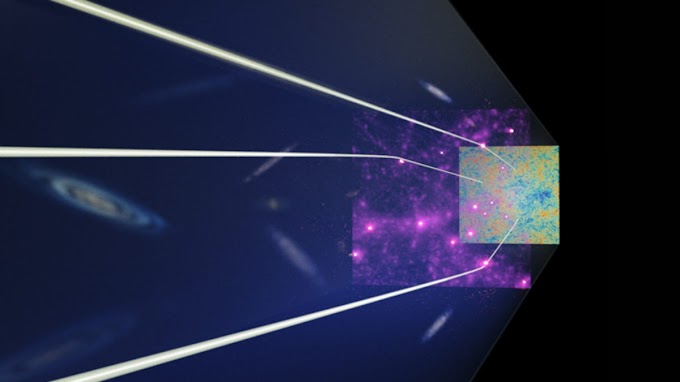As quickly as President Biden unveiled the primary photograph from the James Webb Space Telescope (JWST) on July 11, Massimo Pascale and his team sprang into movement.
 |
| The James Webb Space Telescope’s view of the galaxy NGC 7496 well-knownshows vibrant channels of dust and fuel wherein stars are actively forming. NASA, ESA, CSA, and STScI |
Coordinating over Slack, Pascale, an astrophysicist on the University of California, Berkeley, and 14 collaborators divvied up tasks. The picture confirmed heaps of galaxies in a pinprick-length part of the sky, a few magnified as their light bent round a significant cluster of galaxies. The group set to work scrutinizing the photo, hoping to post the first actual JWST technology paper. “We labored nonstop,” stated Pascale. “It was like an break out room.”
Three days later, just mins earlier than the every day cut-off date on arxiv.org, the server in which scientists can upload early variations of papers, the group submitted their studies. They overlooked out on being first by way of 13 seconds, “which become quite funny,” stated Pascale.
The victors, Guillaume Mahler at Durham University within the United Kingdom and colleagues, analyzed that same first JWST picture. “There became only a sheer pride of being able to take this notable information and publish it,” Mahler stated. “If we can do it speedy, why have to we wait?”
The “wholesome opposition,” as Mahler calls it, highlights the giant quantity of technological know-how that is already coming from JWST, days after scientists started receiving records from the long-awaited, infrared-sensing mega-telescope.
The Dawn of Time
One of JWST’s plenty-touted competencies is the electricity to look back in time to the early universe and see a number of the first galaxies and stars. Already, the telescope — which launched on Christmas Day 2021 and now sits 1.5 million kilometers from Earth — has spotted the maximum remote, earliest galaxy known.
Two teams discovered the galaxy when they separately analyzed JWST observations for the GLASS survey, certainly one of extra than 2 hundred technology applications scheduled for the telescope’s first year in space. Both teams, one led with the aid of Rohan Naidu on the Harvard-Smithsonian Center for Astrophysics in Massachusetts and the alternative with the aid of Marco Castellano at the Astronomical Observatory of Rome, recognised particularly far flung galaxies inside the facts: one up to now away that JWST detects the mild it emitted 400 million years after the Big Bang (a tie with the oldest galaxy ever visible by using the Hubble Space Telescope), and the alternative, dubbed GLASS-z13, seen because it regarded three hundred million years after the Big Bang. “It would be the maximum remote galaxy ever located,” said Castellano.
Both galaxies look extraordinarily small, possibly a hundred instances smaller than the Milky Way, yet they show surprising charges of big name formation and already include 1 billion instances the mass of our sun — more than expected for galaxies this younger. One of the young galaxies even suggests proof of a disk like shape. More studies can be done to interrupt aside their light to glean their traits.
Another early-universe application has also turned up “tremendously distant galaxies,” said Rebecca Larson, an astronomer at the University of Texas, Austin and a member of the Cosmic Evolution Early Release Science (CEERS) survey. Just weeks into the survey, the team has bagged a handful of galaxies from the universe’s first 500 million years, even though Larson and her colleagues haven’t released their genuine findings but. “It’s higher than I imagined and it’s best the start,” she stated.
 |
| The telescope’s first public photo suggests a cluster of galaxies referred to as SMACS 0723, that's so heavy it warps and magnifies the mild from remote galaxies beyond it. NASA, ESA, CSA, and STScI |
More early galaxies cover in the photo of the galaxy cluster presented by using President Biden and studied by using Pascale and Mahler. Called SMACS 0723, the cluster is so heavy that it bends the mild of greater remote items, bringing them into view. Pascale and Mahler discovered as much as 16 remote galaxies which have been magnified within the photograph; their precise ages aren’t but regarded.
The telescope took a closer study one remote galaxy within the image, a smudge of mild that dates to 700 million years after the Big Bang. With its spectrograph, JWST detected heavy elements, mainly oxygen, within the galaxy. Now scientists are hoping the telescope will locate a lack of heavy factors in even earlier galaxies — evidence that those galaxies comprise handiest Population III stars, the hypothesized first stars within the universe, thought to were monstrously big and made absolutely from hydrogen and helium. (Only as the ones stars exploded did they forge heavier factors such as oxygen and spew them into the cosmos.)
“We’re seeking out galaxies in which we see no heavy elements,” stated Andy Bunker, an astrophysicist on the University of Oxford. “That might be a smoking gun for the first era of stars shaped from primordial hydrogen and helium. Theoretically they must exist. It depends whether or not they’re vivid sufficient.”
Galactic Structure
For scientists looking for to apprehend the shape of galaxies and how stars shape within them, JWST has already supplied impactful data.
One gazing application, led by Janice Lee at the National Science Foundation’s NOIR Lab in Arizona, appears for younger sites of star formation in galaxies. On behalf of Lee’s group, JWST located a galaxy 24 million light-years away known as NGC 7496, whose younger megastar-forming areas have till now been shrouded in darkness; Hubble’s gadgets have been not able to penetrate the thick dirt and fuel that surrounds those areas. JWST, although, can see infrared light that bounces off the dust, permitting the telescope to probe close to the moments while the celebs switched on and nuclear fusion ignited of their cores. “The dirt is truly lights up,” stated Lee.
What’s most extraordinary, she stated, is that NGC 7496 is a everyday galaxy, “not a poster-child galaxy.” Yet under the watchful eye of JWST, it unexpectedly comes to life and well-knownshows channels wherein stars are forming. “It’s just phenomenal,” she stated.
John Barentine, an astronomer on the darkish-sky conservation firm Dark Sky Consulting in Arizona, meanwhile, made a extra serendipitous discovery in considered one of JWST’s first images. The telescope’s image of the Southern Ring Nebula, 2,500 mild-years from Earth, confirmed extraordinary readability. Off to the aspect, an interesting galaxy considered part-on (a completely unique vantage factor for studying the galaxy’s valuable bulge), formerly misidentified as part of the nebula itself, poked into view.
“We have this exquisitely touchy gadget that is going to serendipitously reveal things we didn’t even recognise we have been seeking out,” Barentine stated. “In nearly every photograph Webb takes, it’s worth poking round within the heritage.”
An Eye on Stars and Planets
Smaller goals are in JWST’s crosshairs, too, such as the planets of our very own solar gadget. Jupiter regarded in incredible style as part of the primary batch of snap shots, captured in an exposure lasting simply seventy five seconds.
Astronomers understand that Jupiter’s top surroundings is loads of stages warmer than the decrease ecosystem, however they aren’t positive why. By detecting infrared mild, JWST may want to see the heated higher surroundings shining; it seems as a purple ring around the planet. “We have this layer some hundred kilometers above the cloud decks, and it’s glowing as it’s hot,” said Henrik Melin,University of Leicester a planetary scientist at the . “We’ve never visible it like this before on a global scale. That’s an brilliant component to see.”
Melin’s application plans to apply JWST inside the coming weeks to look at the using force behind this atmospheric heating.
Hiding in JWST’s photograph of Jupiter is the volcanic moon Io interacting with Jupiter’s aurora — creating a small bump inside the aurora low within the planet’s sky. The photograph exhibits “cloth coming from Io streaming down the magnetic field traces,” said Melin. The impact has been visible earlier than, however it become without problems picked out with the aid of JWST with slightly a glance on the planet.
JWST is probing planets in different superstar systems too. Already, the telescope has taken a peek on the well-known TRAPPIST-1 device, a pink dwarf superstar with seven Earth-length worlds (some potentially habitable), though the facts continues to be being analyzed. Early observations have been launched of a much less hospitable planet, a “hot Jupiter” called WASP-96b , in a tight 3.Four-day orbit round its megastar.
JWST located water vapor within the planet’s environment, confirming proof of water mentioned days in advance with the aid of Chima McGruder of the Harvard-Smithsonian Center and colleagues, who used a floor-primarily based telescope. But JWST can go similarly; through observing WASP-96 b’s ratio of carbon to oxygen, it can be capable of clear up a confounding mystery about hot Jupiter : how they obtain such close orbits round their stars. More oxygen could suggest that the fuel giant initially formed some distance from the famous person where water could condense, at the same time as a higher carbon ratio could propose that it’s constantly been near in.
Meanwhile, JWST may additionally have noticed a brief mild within the sky — a quick-lived event referred to as a brief — which it become not initially designed to do. The astronomer Mike Engesser and colleagues on the Space Telescope Science Institute in Baltimore, Maryland (the operations middle for JWST), observed a bright item not apparent in Hubble photos of the equal location. They think it’s a supernova, or exploding famous person, some three billion mild-years away — proof that the telescope can locate these activities.
JWST ought to be capable of locating far greater distant supernovas too, which will give it some other manner to serve as a probe of the early universe. It can also discover stars being torn aside via the supermassive black holes that live at galaxies’ facilities, some thing no preceding telescope has visible. “For the first time we’re going so that it will peer into these very deep, dark regions,” said Ori Fox, an astronomer on the Space Telescope Science Institute who leads the team studying transients.
Transients, like different astronomical phenomena, are set to be redefined. After decades of making plans and production, JWST has hit the sky jogging. The issue now could be preserving tempo with the constant barrage of technology coming down from a machine so complex but faultless it almost defies belief that it turned into built through human brains. “It’s working, and it’s insane,” said Larson.














